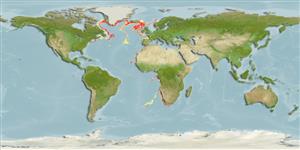Elasmobranchii (tubarões e raias) (sharks and rays) >
Rajiformes (Skates and rays) >
Rajidae (Skates)
Etymology: Malacoraja: Greek, malakos = soft + Latin, raja, -ae = ray, fis (Raja sp.) (Ref. 45335).
More on author: Barnard.
Environment: milieu / climate zone / depth range / distribution range
Ecologia
marinhas batidemersal; intervalo de profundidade 450 - 1570 m (Ref. 117245). Deep-water; 3°C - 5°C (Ref. 117245); 67°N - 38°S, 72°W - 25°E
Eastern Atlantic: Baffin Bay-Davis Strait Offshore to Iceland-Faeroe Ridge, off northwest Africa (Rio de Oro), off southern Namibia and South Africa.
Tamanho / Peso / Idade
Maturity: Lm ? range ? - ? cm
Max length : 70.0 cm TL macho/indeterminado; (Ref. 4426)
Descrição suscinta
Chaves de identificação | Morfologia | Morfometria
Very broad, almost pentagonal disc, light above and abruptly dark below; snout bluntly pointed with a flexible tip, eyes small and close together, and a disc with broadly rounded rear margins and tips (Ref. 5578). Small juveniles with and adults without thorns and covered only with small denticles (Ref. 5578). Slate-grey or greyish-brown above except rear margins of pectoral and pelvic fins and claspers of adult males which are dark brown; dark brown below, sometimes with light blotches (Ref. 5578). Lack of large thorns on its disc posterior to the scapular region (Ref. 6902).
A very rare species inhabiting continental slopes and probably down to the abyssal plains (Ref. 3167). Benthic (Ref. 58426). Adults usually at depths greater than 1,500 m while juveniles are mainly taken from about 450 m downward (Ref. 4426). Minimum depth reported taken from Ref. 4426. Feeds on crustaceans (Ref. 58426). Oviparous (Ref. 50449). Eggs have horn-like projections on the shell (Ref. 205). This species is occasionally captured as by-catch (Ref. 117245).
Ciclo de vida ou comportamento de acasalamento
Maturities | Reprodução | Spawnings | Egg(s) | Fecundities | Larvas
Oviparous (Ref. 3167). Paired eggs are laid. Embryos feed solely on yolk (Ref. 50449).
McEachran, J.D. and K.A. Dunn, 1998. Phylogenetic analysis of skates, a morphologically conservative clade of elasmobranchs (Chondrichthyes: Rajidae). Copeia 1998(2):271-290. (Ref. 27314)
Status na Lista Vermelha da UICN (Ref. 130435)
Ameaça para os humanos
Harmless
Uso pelos humanos
Ferramentas
Relatórios especiais
Baixar XML
Fontes da internet
Estimates based on models
Preferred temperature (Ref.
123201): 3.3 - 8.5, mean 5.9 °C (based on 122 cells).
Índice de diversidade filogenética (Ref.
82804): PD
50 = 0.5625 [Uniqueness, from 0.5 = low to 2.0 = high].
Bayesian length-weight: a=0.00302 (0.00141 - 0.00645), b=3.24 (3.07 - 3.41), in cm total length, based on LWR estimates for this (Sub)family-body shape (Ref.
93245).
Nível Trófico (Ref.
69278): 3.8 ±0.61 se; based on food items.
Resiliência (Ref.
120179): Baixo, tempo mínimo de duplicação da população 4,5 - 14 anos (Fec assumed to be <100).
Fishing Vulnerability (Ref.
59153): Moderate to high vulnerability (48 of 100).
Nutrients (Ref.
124155): Calcium = 9.46 [1.70, 47.25] mg/100g; Iron = 0.362 [0.086, 1.103] mg/100g; Protein = 16.6 [13.7, 19.2] %; Omega3 = 0.61 [0.18, 2.41] g/100g; Selenium = 14.7 [3.9, 48.4] μg/100g; VitaminA = 7.61 [1.88, 30.80] μg/100g; Zinc = 0.341 [0.168, 0.630] mg/100g (wet weight);
